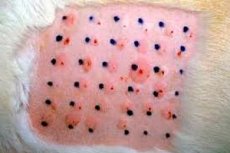Medical expert of the article
New publications
Specific and non-specific hyposensitization
Last reviewed: 04.07.2025

All iLive content is medically reviewed or fact checked to ensure as much factual accuracy as possible.
We have strict sourcing guidelines and only link to reputable media sites, academic research institutions and, whenever possible, medically peer reviewed studies. Note that the numbers in parentheses ([1], [2], etc.) are clickable links to these studies.
If you feel that any of our content is inaccurate, out-of-date, or otherwise questionable, please select it and press Ctrl + Enter.

Specific hyposensitization (or specific immunotherapy) is the creation of resistance to the action of the allergen responsible for hypersensitization by prophylactic administration of this allergen in gradually and strictly individually increased doses, starting from subthreshold.
Indications for the procedure
The method of specific hyposensitization (immunotherapy) is used when it is impossible to completely stop contact with the etiologically significant allergen (for example, in patients with sensitization to house dust, plant pollen, mold fungi, bacterial allergens, etc.).
Technique hyposensitization
The introduction of the allergen begins with a very small dose (1: 1,000,000 - 0.1 ml), and then the dose is gradually increased.
Mechanism of action:
- formation of blocking IgG antibodies;
- decrease in IgE synthesis;
- induction of T-suppressors;
- activation of polymorphonuclear leukocytes;
- increased phagocytosis;
- decreased sensitivity of target cells of allergic reactions to allergens and allergy mediators;
- development of immunological tolerance;
- increased levels of IgA in bronchial mucus;
- stabilization of mast cell membranes.
Allergens used for specific immunotherapy come in different types (water-salt, purified allergens, active fractions of allergens, chemically modified allergens with enhanced immunogenic and weakened allergenic properties, prolonged allergens).
Specific immunotherapy gives a positive therapeutic effect in pollen bronchial asthma - in 70% of patients, in household bronchial asthma - in 80-95% with a disease duration of less than 8 years.
Patients with pollen-induced bronchial asthma undergo a pre-season course of treatment.
A. Ostroumov (1979) demonstrated the high efficiency of specific immunotherapy using purified allergen from ragweed pollen. Purified allergens are better tolerated. S. Titova developed the technology for producing cintanal - a purified sorbed prolonged drug. It has no side effects, which is due to the absence of ballast substances.
In recent years, targeted chemically modified therapeutic allergens have been created:
- allergoids formatted allergens;
- Tolerogens are allergens denatured by urea.
These drugs cause persistent suppression of IgE antibodies, stimulate the formation of IgG antibodies. They have low allergenicity and high immunogenicity.
Experimental studies of allergy vaccines are also being completed. Allergy vaccines are complexes of purified allergens with synthetic polymer carriers. Such preparations inhibit the formation of allergic reagins (IgE antibodies), but enhance the synthesis of blocking IgG antibodies. (A complex of timothy grass pollen allergen and the synthetic polymer polyoxidonium has been obtained).
In recent years, a new direction of specific immunotherapy has been applied - the use of immune complexes consisting of allergens (mite and pollen) and specific autologous antibodies for treatment. During the treatment, the titer of anti-idiotypic immunoglobulins increases. The method is safe, and it is possible to reduce the dose of the administered allergen.
Contraindications to the procedure
Contraindications to specific immunotherapy:
- exacerbation of bronchial asthma and chronic foci of infection;
- exacerbation of concomitant diseases - diabetes mellitus, kidney disease, liver disease, hypertension, coronary heart disease, toxic goiter, blood diseases, systemic connective tissue diseases, other allergic diseases;
- the presence of irreversible changes in lung tissue (emphysema, pneumosclerosis), respiratory or heart failure;
- long-term glucocorticoid therapy;
- mental illness;
- oncological diseases;
- pregnancy and lactation;
- active phase of rheumatism.
Non-specific desensitization
Non-specific desensitization is the use of means and methods that cause a decrease in hypersensitivity to various (not necessarily specific) antigens-allergens.
Non-specific hyposensitization methods include:
- RDT (fasting diet therapy);
- treatment with histaglobulin, allergoglobulin;
- treatment with adaptogens.


 [
[